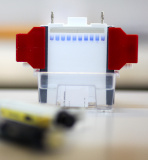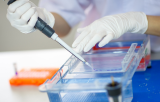
Electrophoresis and blotting
Electrophoresis is a technique for separating electrically charged particles, and is therefore called a separative technique. The separation is done by differential migration under the action of an electric field. The distance travelled and the speed of migration depend on the characteristics of the molecule, such as its size, geometry or electrical charge. For migration, a matrix is used which is a support to guide and slow down the migration of molecules in order to improve their separation. Most often this matrix is a gel which can have different compositions depending on the molecules to be separated (agarose for nucleic acids or polyacrylamide for proteins for example). The choice of support depends on the nature of the molecules to be identified. For example, very small molecules in a gel with too large pores will not be sufficiently slowed down and will therefore be poorly identified. Conversely, large molecules in a mesh that is too fine will be completely blocked. In general, agarose is used for large molecules, for example to separate DNA and RNA. Acrylamide and bisacrylamide form much finer meshes and are therefore suitable for separating lower molecular weight molecules such as proteins.



